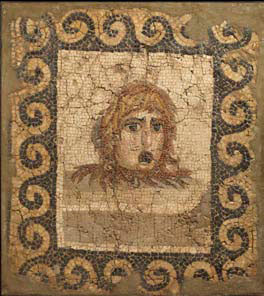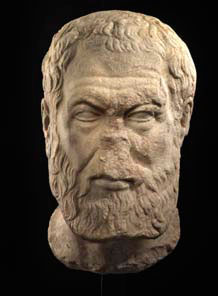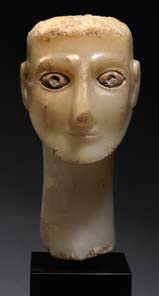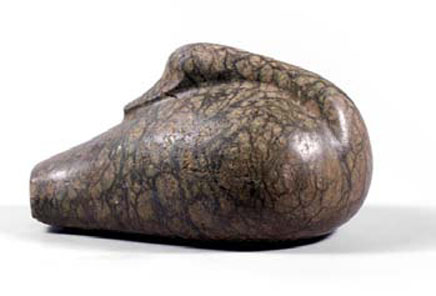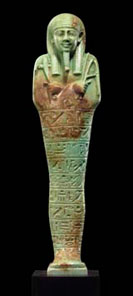January 17, 2013 – Rupert Wace Ancient Art will again be heading across the Atlantic at the start of the New Year. Leaving their gallery in the heart of London’s art dealing district to exhibit at the Winter Antiques Show held annually at the Park Avenue Armory, New York. This year the fair will run from 25 January to 3rd February.
Roman mosaic with the theatre mask, c.2nd century AD Dimensions: 39.5 x 35.25 inches. Price: $150,000.
The focal point of the stand will be a striking Roman mosaic panel of a theatre mask, bordered by a classical wave pattern frieze. Dating from the 2nd century AD, the dramatic face with large eyes and downturned mouth framed by unruly hair. Masks were an important element of Roman theatre, a continuation of the Greek traditions. The actor’s entire head, including his hair, would be covered by the mask which was of simple design with large holes for the eyes and mouth. Very few actual masks survive as they were made of linen or cork.
The classical world will also be represented by a small collection of Roman marble portrait heads, varying in date and subject matter they all reveal the skill of the Roman artist in capturing character. The Roman period arguably saw the birth of true portraiture. It became the dominant genre of Roman art perhaps as the result of their obsession with ancestry. The Egyptians and Greeks had been concerned with an “Ideal” but here we see a striking realism and new emphasis on character.
Roman marble head of Hypereides, c.2nd century AD. Height: 13 inches. Price: $280,000.
Early influences continued and Greek originals were still copied as is the case with the head of the Attic orator, Hypereides, based on a lost bust set up in 307 BC by the Athenians to honour the supporter of the city after the defeat of the Macedonians. But here too the personality of the sitter is foremost; renowned as “an ardent pursuer of the beautiful”, Hypereides easy-going nature is evident.
Roman marble portraithead of a young boy, Antonine, 138-193 AD. Height: 7.25 inches. Price: $90,000.
The young boy, probably dating from the Antonine Period of the late 2nd century AD, is a particularly charming example. The quality of the workmanship evident here suggests that this may represent an Imperial child or, at the least, the adored child of a wealthy family.
none
Roman marble portrait head, mid 3rd century AD. Height: 9.5 inches. Price: $200,000.
The third portrait depicts a handsome man in the prime of his life. The features show some similarity to the portraits of the young Alexander Severus (208-235 AD) found in the collections of the Uffizi, Florence and the Louvre, Paris. The last Emperor of the Severan Dynasty, his reign was followed by turbulent times and a succession of short-lived rulers and usurpers. This is a fine head from a period from which relatively little good sculpture is preserved.
South Arabian alabaster head, c.1st century-1st century AD. Height: 8 inches. Price: $100,000.
The current trend for collecting works of art from ancient times has been inspired by the aesthetic affinity of such pieces with contemporary taste. This appeal can be seen in the simple form of the alabaster head of a man from the biblical land of Sheba, in modern-day Yemen. Large, inlaid oval eyes gaze straight out at the viewer from a narrow, oval face with high, well-defined cheekbones. A neat, sharp beard follows the contours of his face.
Mesopotomian stone duck weight, 2nd millenium BC.Length: 8.75 inches. Price: $75,000.
The attraction of a simple line is also illustrated in another piece from the ancient Near East. A stone weight in the form of a stylised duck, the head and neck of the bird turned back and carved in relief against the body, comes from Mesopotamia, the cradle of cilvilisation. These were made for a practical purpose and yet it is clear that, even four thousand years ago, their aesthetic quality was important.
Egyptian faience ushabti, Late Dynastic Period. Height: 10.25 inches. Price: $175,000.
The arts of ancient Egypt will be represented by an exceptionally fine ushabti, standing over 10 inches high, from the tomb of Tchahorpata (or Tjai-hor-pa-ta), son of Tefnout, an influential courtier during the 30th Dynasty. Coming originally from a private collection in Alexandria, the figure was sold in Paris in 1912 and was exhibited at the Burlington Fine Arts Club, London in 1922, loaned by Mr Henry Oppenheimer. More recently it was part of the important Bouché Collection in Paris. The typically mummiform figure is inscribed on the front with ten horizontal rows of hieroglyphs including the names of the subject which included the enigmatic title “He who knows what exists”. This example can be dated with some precision as his sarcophagus, now in Cairo, gives the year of his death as year 15 of the reign of Nectanebo II, c.345 BC.
Howard Carter (1874-1939), Watercolour study of the throne of Queen Neith. Framed dimensions: 16 x 34.5 inches. Price: $44,000.
The world of the ancient Egyptians has long held us in its thrall and the name Howard Carter conjures up wonderful images of gold masks and amazing treasures. Though famous c.345 BC for his sensational discovery of the tomb of Tutankhamun he was also an accomplished artist as is evident in the watercolour study of the throne of Queen Neith at Saqqara which will hang on the stand of Rupert Wace Ancient Art. His paintings were often commissions or, as in this case, gifts to friends, and rarely appear on the art market. They often provide a record of monuments now lost or damaged.
For further information, please contact the gallery via e-mail.
You can find the gallery online at Rupert Wace Ancient Art.
For more information about the Winter Antiques Show visit its website.




